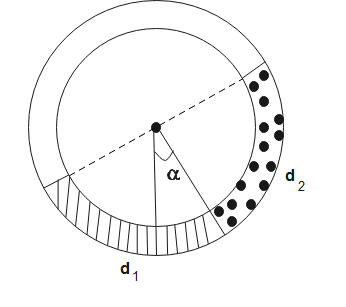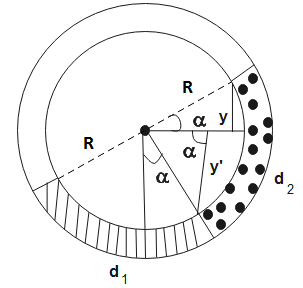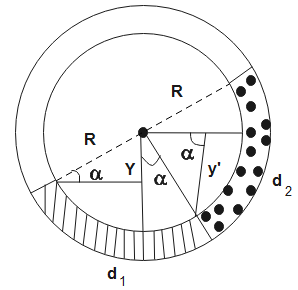
There is a circular tube in a vertical plane. Two liquids which do not mix and are of densities ${{d}_{1}}$ and ${{d}_{2}}$ are filled in the tube. Each liquid subtends ${{90}^{o}}$ angle at the centre. Radius joining their interface makes an angle $\alpha $ with the vertical. Ratio of $\dfrac{{{d}_{1}}}{{{d}_{2}}}$ is-
(A). $\dfrac{1+\tan \alpha }{1-\tan \alpha }$
(B). $\dfrac{1+\sin \alpha }{1-\cos \alpha }$
(C). $\dfrac{1+\sin \alpha }{1-\sin \alpha }$
(D). $\dfrac{1+\cos \alpha }{1-\cos \alpha }$


Answer
514.8k+ views
Hint: Two liquids of densities do not mix with each other and are at equilibrium at the interface. Using Bernoulli’s equation, we can calculate the pressure of each liquid. As they are at equilibrium at the interface, pressure due to both liquids will be equal and opposite.
Formulas Used:
$P={{P}_{o}}+\rho gh$
Complete answer:
Given two liquids of density ${{d}_{1}}\,\text{and}\,{{d}_{2}}$ are filled in a tube and do not mix with each other. Both subtend an angle ${{90}^{o}}$ at the centre.
At the interface, both liquids are at equilibrium. Therefore, the pressure due to both liquids is equal at the interface.
According to Bernoulli’s theorem, the pressure due to liquids is-
$P={{P}_{o}}+\rho gh$ ---- (1)
Here,$P$ is pressure due to the liquid
${{P}_{o}}$ is atmospheric pressure
$\rho $ is density of the liquid
$g$ is acceleration due to gravity
$h$ is its height
For liquid-1,

From the figure, we can see that,
$\begin{align}
& y=R\sin \alpha \\
& y'=R\cos \alpha \\
\end{align}$
So the height of liquid with density${{d}_{2}}$will be-$R(\sin \alpha +\cos \alpha )$
From eq (1), the pressure of liquid will be-
${{P}_{2}}={{P}_{0}}+{{d}_{2}}gR(\sin \alpha +\cos \alpha )$ ---- (2)

Form the above figure, we can see that,
$\begin{align}
& y'=R\cos \alpha \\
& Y=R\sin \alpha \\
\end{align}$
So the height of liquid with density${{d}_{1}}$will be-$R(\cos \alpha -\sin \alpha )$
From eq (1), the pressure of the liquid is-
${{P}_{1}}={{P}_{0}}+{{d}_{1}}gR(\cos \alpha -\sin \alpha )$ ---- (3)
At the interface pressure is same, therefore equating eq (2) and eq (3), we get,
$\begin{align}
& {{P}_{0}}+{{d}_{1}}gR(\cos \alpha -\sin \alpha )={{P}_{0}}+{{d}_{2}}gR(\sin \alpha +\cos \alpha ) \\
& \Rightarrow {{d}_{1}}(\cos \alpha -\sin \alpha )={{d}_{2}}(\sin \alpha +\cos \alpha ) \\
& \Rightarrow \dfrac{{{d}_{1}}}{{{d}_{2}}}=\dfrac{\sin \alpha +\cos \alpha }{\cos \alpha -\sin \alpha } \\
\end{align}$
Dividing the above equation by$\cos \alpha $, we get,
$\therefore \dfrac{{{d}_{1}}}{{{d}_{2}}}=\dfrac{1+\tan \alpha }{1-\tan \alpha }$
The ratio of $\dfrac{{{d}_{1}}}{{{d}_{2}}}$is$\dfrac{1+\tan \alpha }{1-\tan \alpha }$.
Hence, the correct option is (A).
Note:
Pressure due to a fluid is the force exerted by it per unit area. A fluid enclosed in a container exerts pressure in all the directions. Bernoulli’s principle says that when the velocity of fluid increases, its potential energy decreases. Bernoulli's principle follows the law of conservation of energy, i.e. sum of all energies possessed by the flowing fluid is constant.
Formulas Used:
$P={{P}_{o}}+\rho gh$
Complete answer:
Given two liquids of density ${{d}_{1}}\,\text{and}\,{{d}_{2}}$ are filled in a tube and do not mix with each other. Both subtend an angle ${{90}^{o}}$ at the centre.
At the interface, both liquids are at equilibrium. Therefore, the pressure due to both liquids is equal at the interface.
According to Bernoulli’s theorem, the pressure due to liquids is-
$P={{P}_{o}}+\rho gh$ ---- (1)
Here,$P$ is pressure due to the liquid
${{P}_{o}}$ is atmospheric pressure
$\rho $ is density of the liquid
$g$ is acceleration due to gravity
$h$ is its height
For liquid-1,

From the figure, we can see that,
$\begin{align}
& y=R\sin \alpha \\
& y'=R\cos \alpha \\
\end{align}$
So the height of liquid with density${{d}_{2}}$will be-$R(\sin \alpha +\cos \alpha )$
From eq (1), the pressure of liquid will be-
${{P}_{2}}={{P}_{0}}+{{d}_{2}}gR(\sin \alpha +\cos \alpha )$ ---- (2)

Form the above figure, we can see that,
$\begin{align}
& y'=R\cos \alpha \\
& Y=R\sin \alpha \\
\end{align}$
So the height of liquid with density${{d}_{1}}$will be-$R(\cos \alpha -\sin \alpha )$
From eq (1), the pressure of the liquid is-
${{P}_{1}}={{P}_{0}}+{{d}_{1}}gR(\cos \alpha -\sin \alpha )$ ---- (3)
At the interface pressure is same, therefore equating eq (2) and eq (3), we get,
$\begin{align}
& {{P}_{0}}+{{d}_{1}}gR(\cos \alpha -\sin \alpha )={{P}_{0}}+{{d}_{2}}gR(\sin \alpha +\cos \alpha ) \\
& \Rightarrow {{d}_{1}}(\cos \alpha -\sin \alpha )={{d}_{2}}(\sin \alpha +\cos \alpha ) \\
& \Rightarrow \dfrac{{{d}_{1}}}{{{d}_{2}}}=\dfrac{\sin \alpha +\cos \alpha }{\cos \alpha -\sin \alpha } \\
\end{align}$
Dividing the above equation by$\cos \alpha $, we get,
$\therefore \dfrac{{{d}_{1}}}{{{d}_{2}}}=\dfrac{1+\tan \alpha }{1-\tan \alpha }$
The ratio of $\dfrac{{{d}_{1}}}{{{d}_{2}}}$is$\dfrac{1+\tan \alpha }{1-\tan \alpha }$.
Hence, the correct option is (A).
Note:
Pressure due to a fluid is the force exerted by it per unit area. A fluid enclosed in a container exerts pressure in all the directions. Bernoulli’s principle says that when the velocity of fluid increases, its potential energy decreases. Bernoulli's principle follows the law of conservation of energy, i.e. sum of all energies possessed by the flowing fluid is constant.
Recently Updated Pages
Master Class 12 Business Studies: Engaging Questions & Answers for Success

Master Class 12 Biology: Engaging Questions & Answers for Success

Master Class 12 Physics: Engaging Questions & Answers for Success

Class 12 Question and Answer - Your Ultimate Solutions Guide

Master Class 12 English: Engaging Questions & Answers for Success

Master Class 12 Economics: Engaging Questions & Answers for Success

Trending doubts
Which are the Top 10 Largest Countries of the World?

What is transplantation in agriculture class 12 biology CBSE

Differentiate between homogeneous and heterogeneous class 12 chemistry CBSE

Why is the cell called the structural and functional class 12 biology CBSE

Who discovered the cell and how class 12 biology CBSE

What is the Full Form of PVC, PET, HDPE, LDPE, PP and PS ?




